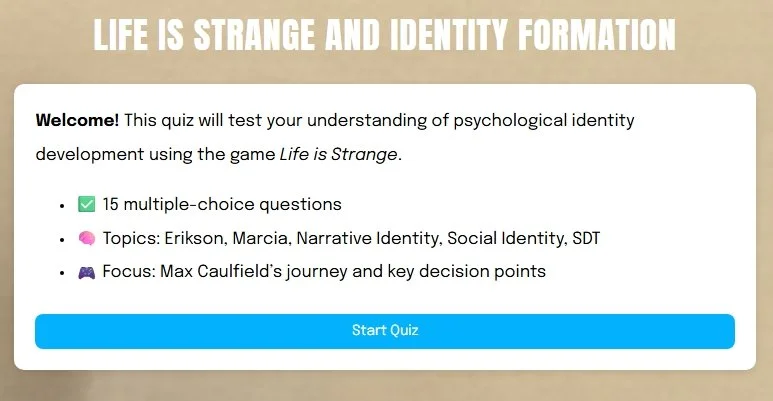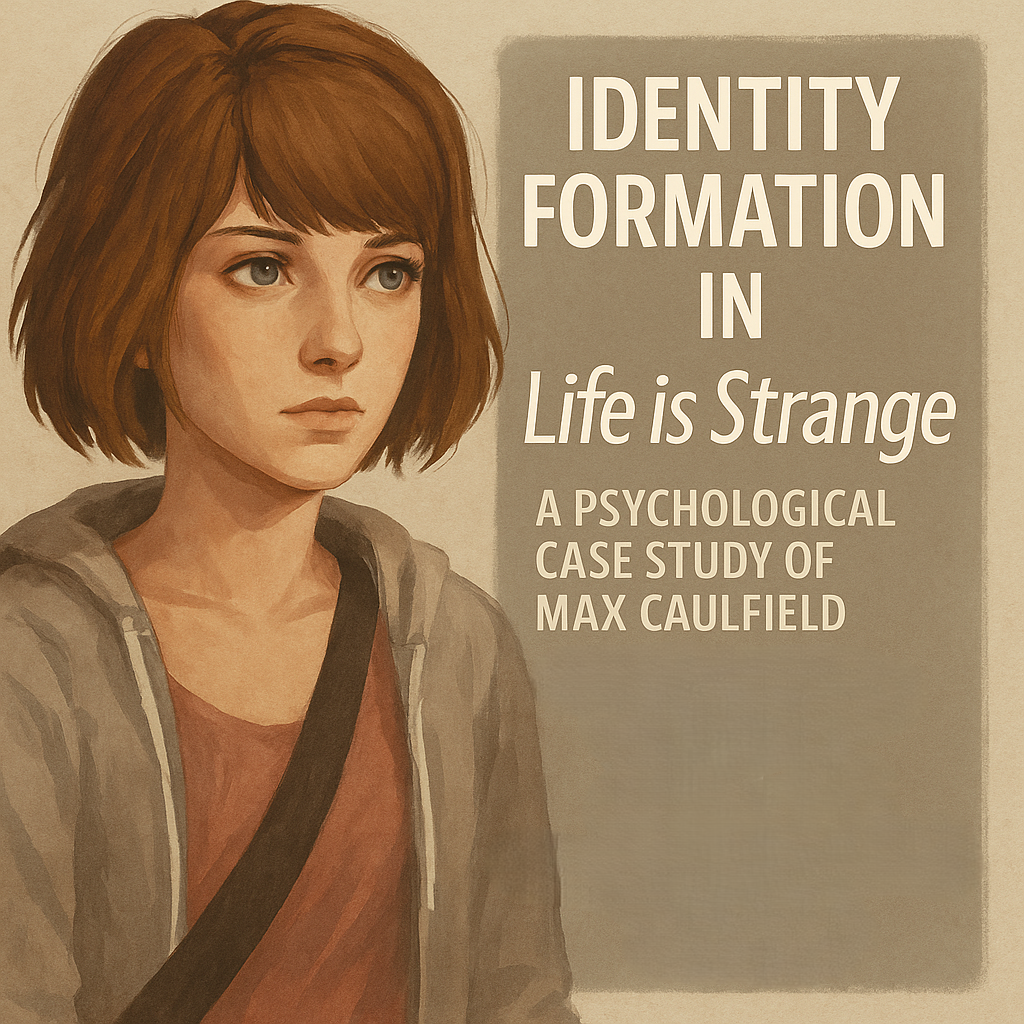Playing Through Identity: Max Caulfield and Adolescent Development
This guide delves into the fundamental psychological concept of identity formation, a pivotal developmental task during adolescence and early adulthood. We leverage the compelling narrative video game Life is Strange and its protagonist, Max Caulfield, as a detailed case study. The unique interactive nature of video games provides a rich, "real-life-like" simulation for exploring complex psychological phenomena, allowing for an immersive understanding of theoretical constructs.
This guide will introduce you to foundational theories, specifically Erik Erikson's psychosocial stages and James Marcia's identity status theory, alongside complementary perspectives such as Social Identity Theory, Narrative Identity Theory, and Self-Determination Theory. Through a critical examination of Max's journey, you will gain a deeper understanding of how identity is dynamically shaped by interpersonal relationships, significant choices, and profound internal conflicts.
Spoilers ahead for Life is Strange
Setting the Stage: The World of Life is Strange
To fully understand Max Caulfield’s identity journey, it is important to first understand the world she inhabits and the unique narrative structure of Life is Strange.
Life is Strange is a choice-based, episodic adventure game developed by Dontnod Entertainment. It follows the story of Maxine "Max" Caulfield, an 18-year-old photography student who returns to her hometown, Arcadia Bay, to attend the prestigious Blackwell Academy. Max is quiet, introspective, and deeply empathetic—an observer rather than a participant at the outset of the story.
Early in the game, Max discovers she has a supernatural ability to rewind time, allowing her to alter events and their outcomes. This power becomes both a gift and a burden, forcing her to navigate complex interpersonal relationships, moral dilemmas, and the increasingly dire consequences of her actions. Her journey is complicated further by the reappearance of her estranged childhood friend, Chloe Price, a rebellious and emotionally wounded young woman whose influence is central to Max’s transformation.
The narrative is framed around themes of:
Choice and consequence: Every decision impacts future events, creating ripple effects
Friendship and loyalty: Particularly the evolving and emotionally intense bond between Max and Chloe
Moral ambiguity: Few choices are clearly “right” or “wrong”
Time and responsibility: Max must reckon with the ethical implications of manipulating time
Importantly, Life is Strange is not just a story about identity formation—it is a game that asks players to shape that identity through their own choices, which creates a deeply immersive and reflective experience. The player becomes co-author of Max's identity, making the psychological journey both narrative and experiential.
This emotionally charged, interactive format makes Life is Strange an exceptional case study for exploring identity development through the lens of modern psychological theory.
What is Identity?
Identity refers to the stable and coherent sense of who an individual is, encompassing their unique values, deeply held beliefs, future goals, and overall self-concept. During the formative years of adolescence and early adulthood, individuals frequently grapple with fundamental questions such as "Who am I?", "What do I believe in?", and "What do I want to do with my life?". This period marks a crucial phase where the self-concept begins to integrate both personal traits and achievements with various social affiliations.
Crucially, identity is not a fixed trait but rather a dynamic and evolving construct. Its development is an ongoing process characterized by continuous exploration of various possibilities and subsequent commitment to specific roles, values, and beliefs. This interplay of exploration and commitment forms the theoretical bedrock of many identity development frameworks, highlighting identity as a fluid and adaptive aspect of our personalities that continues to be refined throughout our lifespans.
Theoretical Background
Erikson’s Psychosocial Theory
Erik Erikson's psychosocial theory offers a comprehensive framework for understanding human development, proposing that individuals navigate eight distinct stages throughout their lives. Each stage presents a unique psychosocial crisis or central conflict that, when successfully resolved, contributes to the development of a healthy personality and specific ego strengths.
The fifth stage, Identity vs. Role Confusion, typically occurs during adolescence (ages 12–18) and is considered particularly critical for the formation of a personal identity. The central conflict within this stage involves individuals striving to develop a coherent sense of self by integrating various roles, beliefs, and experiences into a unified identity. This period is marked by a significant internal and external search for self-definition.
A successful resolution of this stage culminates in a strong, integrated sense of self, leading to the ego strength of fidelity. Fidelity represents the ability to remain true to oneself and one's values, even in the face of challenges and conflicting pressures. Conversely, a failure to navigate this stage effectively can result in role confusion, characterized by uncertainty about one's self, values, and future direction. This unresolved state can manifest as a weak sense of self, a feeling of being lost, or even social isolation, as the individual struggles to find their place and purpose. Understanding this foundational theory provides essential context for analyzing Max Caulfield's developmental journey.
| Stage | Central Conflict | Positive Outcome | Negative Outcome |
|---|---|---|---|
| 5. Identity vs. Role Confusion | Developing a sense of self | Strong identity | Confusion about self and future |
| ✅ Success: Leads to fidelity (faithfulness to values and self) | ❌ Failure: Results in role confusion, isolation, or a weak sense of self |
Marcia’s Identity Status Theory
Building upon Erikson's foundational work, James Marcia refined the concept of identity crisis by identifying four distinct "identity statuses." These statuses categorize individuals based on the presence or absence of two crucial dimensions: exploration and commitment. Exploration refers to the active process of questioning, experimenting with, and considering different roles, values, and beliefs. Commitment, on the other hand, denotes the degree to which an individual has made firm decisions and invested in a particular identity path. Marcia's framework provides a practical lens through which to observe and categorize the dynamic process of identity development.
The four identity statuses are:
- Identity Achievement: Individuals in this status have engaged in significant personal exploration of various alternatives and have subsequently made firm, self-chosen commitments to their values, beliefs, and goals. They possess a clear and coherent sense of who they are, having actively resolved their identity questions.
- Moratorium: This status describes individuals who are actively exploring different options and questioning their beliefs but have not yet made definitive commitments. It is often a period of significant crisis, uncertainty, and active search, as individuals experiment with various roles and ideologies without settling on one.
- Foreclosure: Individuals in foreclosure have committed to an identity without engaging in substantial personal exploration. Their values, beliefs, and roles are often adopted directly from others, such as parents, authority figures, or cultural expectations, without critical questioning or a personal sense of ownership.
- Diffusion: This status characterizes individuals who lack clear direction, have not actively explored different options, and have made no firm commitments. They may feel apathetic, overwhelmed, or unconcerned about their identity, often drifting without a clear sense of purpose or belonging.
This framework offers a valuable tool for analyzing Max's state at various points in the narrative, allowing for a direct application of the theory to her character development.
| Status | Exploration | Commitment | Example |
|---|---|---|---|
| Identity Achievement | Yes | Yes | Explored options and made firm decisions |
| Moratorium | Yes | No | Still exploring, undecided |
| Foreclosure | No | Yes | Accepted others’ values without questioning |
| Diffusion | No | No | Lacks direction and commitment |
Social Identity Theory
Introduced by psychologist Henri Tajfel, Social Identity Theory posits that an individual's self-concept is not formed in isolation but is significantly derived from their membership in social groups, alongside their personal identity. This theory explains how individuals derive self-esteem from their group affiliations and how group dynamics influence self-perception, driving a fundamental human motivation to achieve and maintain a positive self-concept.
The process of social identity formation unfolds through three psychological stages:
- Social Categorization: Individuals classify themselves and others into various groups based on criteria such as occupation, religious affiliation, political orientation, or ethnicity. This cognitive process creates distinctions between "ingroups" (groups one identifies with) and "outgroups" (groups one does not identify with).
- Social Identification: In this stage, individuals internalize group membership as part of their self-concept, adopting the norms, values, and behaviors of the group they identify with. This process often fosters an emotional attachment and a sense of shared purpose, deepening the psychological bond between the individual and the group.
- Social Comparison: Individuals evaluate their own group's status or value in relation to other groups. The goal of these comparisons is often to establish the superiority or "positive distinctiveness" of one's own group, which can enhance self-esteem and lead to in-group favoritism, competition, or even the downplaying of internal flaws.
Max's initial introversion and detachment from peers suggest a lack of strong social identification at the start of her story. Her re-connection with childhood friend Chloe Price immediately provides her with a new, strong "in-group" affiliation. Chloe's bold, rebellious, and loyal personality significantly influences Max's behaviors and values through a process of social identification. Max's choices to protect Chloe or other individuals (like Kate Marsh) can be understood as prioritizing specific social affiliations, demonstrating how group dynamics and loyalty contribute to her evolving self-concept.
A significant dynamic observed in Max's journey is how her social identity, particularly through her bond with Chloe, becomes a powerful force shaping her self-concept while simultaneously generating profound internal conflict. Max initially struggles to find her place, feeling detached from the dominant social cliques at Blackwell Academy. The reunion with Chloe, a distinct "outsider" figure, serves as a catalyst, providing Max with a strong new social identification. As Max internalizes Chloe's norms and behaviors, adopting a bolder and more assertive stance, her new allegiance often puts her at odds with other social norms or broader moral expectations. This forces her to choose between loyalty to Chloe (her immediate in-group) and broader moral obligations to the community or other individuals (e.g., Kate Marsh, or the ultimate choice to sacrifice Arcadia Bay or Chloe). This highlights how the fundamental human drive for a positive self-concept through group affiliation can lead to complex moral dilemmas when loyalties to different groups clash, forcing an individual to prioritize and integrate conflicting aspects of their identity. This demonstrates that identity formation is not solely an individual's internal psychological process but is profoundly influenced by the social groups one belongs to, and the conflicts that arise when these group loyalties are challenged, pushing individuals to define their core values.
Narrative Identity Theory
Developed by Dan McAdams, Narrative Identity Theory posits that individuals construct their identity by integrating their life experiences into an internalized, evolving "life story". This narrative binds the remembered past with the perceived present and imagined future, providing the individual with a sense of unity, purpose, and self-continuity. This life story is unique to each person, representing an "insider perspective" on personhood.
A life story is structured like a traditional narrative, featuring characters, episodes, imagery, settings, plots, and themes. Key domains of narrative identity include structural elements (such as the details, facts, and chronology of the story), motivational/affective themes (focusing on intertwined motives and emotions), and autobiographical reasoning (the process of making sense of events and connecting them across time). A crucial aspect of narrative identity is "meaning-making"—the extent to which an individual gleans insight and coherence from their experiences, particularly from negative or conflicting events. This process of deriving meaning from one's life narrative is strongly linked to psychological well-being.
Max's consistent journaling throughout the game serves as a literal manifestation of her attempting to construct and make sense of her evolving narrative identity. Her time-rewind powers uniquely disrupt the linear progression of her "life story," forcing her to constantly re-evaluate and re-integrate her past and present. The game's overarching narrative structure, culminating in a defining choice, mirrors the process of committing to a coherent life story.
Max's extraordinary ability to rewind time presents a profound and unique challenge to the formation of a coherent narrative identity. Narrative identity fundamentally relies on binding the remembered past with the present and imagined future to create self-continuity. Max's power to literally alter past events means her "remembered past" is constantly in flux, potentially creating multiple, conflicting versions of reality. This fluidity could theoretically fragment her sense of self and make it incredibly difficult to establish a stable, unified life story. However, the game's design doesn't allow for consequence-free alterations; it forces her to confront the unforeseen and often devastating ripple effects of these changes (e.g., Chloe's paralysis in an alternate timeline, the escalating storm threatening Arcadia Bay). This inescapable weight of consequence compels Max to engage in a deeper, more profound process of meaning-making as she grapples with the ethical and emotional burden of her actions. Ultimately, the narrative's climax, the singular, defining final choice, forces Max to commit to a specific reality and accept its implications, thereby re-establishing a coherent, albeit potentially painful, narrative for her life. Her journal, therefore, becomes not just a personal record but a critical tool for her to process, reflect upon, and attempt to integrate these chaotic and shifting realities, actively constructing her evolving self-narrative amidst unprecedented challenges. This highlights that true narrative coherence might not come from a perfectly linear or ideal past, but from an individual's capacity to confront and integrate chaotic or painful experiences into a meaningful story, especially when faced with unavoidable, high-stakes consequences. This deepens the understanding of how resilience and meaning-making contribute to identity.
Self-Determination Theory (SDT)
Developed by psychologists Edward Deci and Richard Ryan, Self-Determination Theory (SDT) is a macro theory of human motivation and personality. It posits that individuals possess innate tendencies towards psychological growth and well-being, which are fostered when three basic psychological needs are satisfied: autonomy, competence, and relatedness. These needs are considered universal and innate, providing the basis for self-motivation and personality integration.
The three basic psychological needs are:
- Autonomy: This refers to the fundamental desire to be the causal agent of one's own life, acting in harmony with one's integrated self. It signifies a feeling of overall psychological liberty and freedom of internal will, rather than complete independence from others. When individuals feel autonomously motivated, their performance, wellness, and engagement are heightened. Research indicates that external rewards can undermine intrinsic motivation by diminishing autonomy, while offering choices can boost it.
- Competence: This need involves seeking to control outcomes and experience mastery. Feeling capable of success increases the likelihood of taking actions to achieve goals. Positive feedback and opportunities for skill acquisition enhance this need, while negative feedback can undermine it.
- Relatedness: This is the innate drive to interact with, be connected to, and experience caring for others. A sense of belonging and attachment to others is crucial for psychological growth and well-being. Nurturing social environments are particularly important for the actualization of inherent potential.
SDT assumes that people are inherently driven to grow, seeking to master challenges and embrace new experiences to develop a cohesive sense of self. Optimal development occurs when these basic needs are nurtured by supportive social environments.
Max's acquisition of rewind powers directly impacts her sense of competence (mastering a unique ability) and autonomy (gaining control over situations). Her re-established and deepening relationship with Chloe fulfills her crucial need for relatedness. The difficult choices she faces, particularly the profound moral dilemmas, test her self-determination and force her to align her actions with her developing values, thereby driving her psychological growth.
Max's time-rewind power initially appears to grant her ultimate autonomy and competence, allowing her to control outcomes and "fix" mistakes. However, the narrative quickly reveals a profound paradox: this immense power often paradoxically undermines her true autonomy by imposing overwhelming responsibility and generating unforeseen, devastating consequences. Research on omnipotence suggests it can lead to an "inordinate compassion and a quiet but overwhelming sense of responsibility", which Max experiences as she feels compelled to interfere and rescue others. The "butterfly effect" means that even well-intentioned actions can lead to outcomes far worse than the original, making her feel less in control and burdened by the weight of her decisions, despite her ability to manipulate time. This constant struggle with the unpredictable nature of her power and its repercussions challenges her sense of competence. The ultimate binary choice at the end of the game (Sacrifice Chloe or Arcadia Bay) further illustrates that true self-determination is not about having limitless power or avoiding negative outcomes, but about exercising agency within inherent constraints and making a defining, often painful, commitment based on one's core values, thereby strengthening her integrated self. This case study challenges a simplistic view of power as equivalent to autonomy, suggesting that genuine self-determination and psychological growth often emerge from confronting limitations, accepting responsibility for consequences, and making difficult, value-aligned choices, even when those choices are painful.
| Theory | Key Concept 1 | Key Concept 2 | Application to Max |
|---|---|---|---|
| Erikson’s Psychosocial Theory | Identity vs. Role Confusion | Fidelity | Max's journey to find her true self and values |
| Marcia’s Identity Status Theory | Exploration/Commitment | Identity Statuses | Categorizing Max's identity development (e.g., Moratorium) |
| Social Identity Theory | In-groups/Out-groups | Social Identification | Chloe as Max's "in-group" influencing her values and choices |
| Narrative Identity Theory | Life Story | Meaning-Making | Max's journal & time powers disrupting/re-forming her story |
| Self-Determination Theory | Autonomy/Competence/Relatedness | Psychological Growth Paradox | Powers create responsibility, challenging true autonomy |
Max Caulfield: A Case Study in Identity Formation
Max Caulfield is introduced as an 18-year-old aspiring photographer who returns to her hometown of Arcadia Bay to study at the prestigious Blackwell Academy. At the story's outset, Max is portrayed as deeply introverted, uncertain, and anxious, often struggling with self-doubt and relying on others to define her. Her personal journal serves as a private outlet for her thoughts and observations, hinting at her rich internal world but also her reluctance to express herself outwardly. She struggles with speaking up in class and connecting with peers, reflecting a sense of detachment.
A pivotal moment, and the primary catalyst for her identity journey, is her re-connection with her estranged childhood best friend, Chloe Price. This reunion, which neither Max nor Chloe would have initiated on their own due to Max's anxiety and Chloe's perception of Max, fundamentally "kickstarts" Max's self-discovery and growth.
Identity in Action: Max’s Journey
Early Moratorium (Uncertainty and Exploration)
At the beginning of Life is Strange, Max Caulfield clearly embodies the characteristics of Marcia's Moratorium identity status. As an 18-year-old, she is at a typical age for this stage, actively exploring her path without having made firm commitments to her values or future direction. Her introverted nature, self-doubt, and anxiety are evident in her struggles to speak up in class, her difficulty connecting with peers, and her reliance on her journal as a private outlet for her thoughts and observations. She feels detached from the social scene at Blackwell and uncertain about her future, particularly regarding her artistic aspirations, despite her inherent talent. This period is marked by questioning her role and place in the world, a hallmark of moratorium, where she is engaged in active exploration but has not yet made commitments to a defined identity.
Key Point: Moratorium describes individuals who are actively exploring different options and questioning their beliefs but have not yet made definitive commitments. It is often a period of significant crisis, uncertainty, and active search, as individuals experiment with various roles and ideologies without settling on one.
Catalyst for Change: Gaining the Rewind Power
Max's discovery of her extraordinary ability to rewind time, immediately after witnessing Chloe Price's shooting, serves as the primary and most profound catalyst for her identity journey. This supernatural power thrusts her from a passive observer into a position of immense control and overwhelming responsibility, forcing her out of her introverted and indecisive tendencies.
The psychological impact of this time manipulation is multifaceted. Max gains a form of "omnipotence" over immediate events, allowing her to alter outcomes and "fix" mistakes. However, this power rapidly transforms into a significant psychological burden. Feelings of omnipotence, can lead to an "inordinate compassion and a quiet but overwhelming sense of responsibility". Max feels compelled to interfere and "rescue" others, often taking on excessive caretaking responsibilities. The constant need to make difficult decisions that affect others' lives, coupled with the mental exhaustion of using her powers, creates significant internal conflict and emotional strain.
Max's literal ability to "undo" actions and their immediate consequences presents a profound psychological paradox for her moral development. While "undoing" can function as a defense mechanism to prevent emotional pain and circumvent the negative feedback of guilt and shame, which are crucial for moral learning, Life is Strange doesn't allow Max to escape moral growth easily. Instead, her seemingly limitless power to reverse time leads to unforeseen, larger-scale, and often more devastating consequences (e.g., the escalating storm or Chloe's alternate reality paralysis). These unavoidable, higher-stakes repercussions force Max to confront the true weight of her decisions in a way that mere immediate consequences might not. This means that instead of hindering her moral development by allowing her to avoid responsibility, the game's mechanics paradoxically accelerate it by presenting her with existential dilemmas where the "right" choice is ambiguous and deeply painful. She learns that true moral growth stems from confronting inescapable consequences and making value-driven commitments, rather than simply avoiding or erasing mistakes. The emotional burden is not circumvented but intensified, leading to a more profound and accelerated moral development than might occur in a "normal" scenario.
The game deeply explores the philosophical and psychological tension between destiny and free will. Max's rewind powers offer her a profound degree of control, allowing her to exert her "free will" and defy immediate fate. However, the overarching narrative, particularly the impending destructive storm, suggests a powerful underlying "destiny" or "natural order" that resists her meddling, creating a sense of inevitability. This constant interplay forces Max to explore her values: should she interfere, play it safe, or speak up? Ultimately, her journey becomes about defining her agency and purpose within these cosmic constraints, culminating in a choice that defines her stance on fate versus self-determination.
Relationships and Identity
Max's identity is profoundly shaped and accelerated by her interpersonal relationships, which serve as crucial external influences on her internal development. The re-connection with Chloe Price is the primary "kickstarter" for Max's character development. Chloe, with her bold, rebellious, and fiercely loyal personality, consistently challenges Max to step out of her comfort zone, confront difficult situations, and develop a stronger, more assertive sense of self. Their rekindled friendship forces Max to overcome her initial anxiety and self-doubt, pushing her towards risk-taking and greater self-expression. The game's central theme revolves around their evolving bond and how its growth directly affects their individual personal changes and actions.
Warren Graham represents a more cautious, academic, and consistently supportive influence, offering a contrast to Chloe's impulsive nature. Max's interactions with him allow her to explore different facets of her emerging identity, balancing her newfound boldness with her inherent analytical and caring tendencies. While often in the background, Warren provides a steady presence that contributes to Max's sense of relatedness, a key component of self-determination theory.
Kate Marsh's severe crisis, exacerbated by bullying, serves as a critical moral turning point for Max and the player. Max's decision to actively intervene and stand up for Kate, driven by deep empathy, forces her to act on her values and assert herself in a high-stakes, emotionally charged situation. This event solidifies Max's identity as a protector and someone willing to fight for what she believes is right, moving her decisively beyond passive observation and into active engagement.
Through these dynamic relationships, Max adopts various roles—friend, confidante, protector, artist, detective each contributing significantly to her evolving self-concept and sense of purpose. Her identity is not merely about who she is intrinsically, but also profoundly shaped by the roles she performs and the responsibilities she embraces in relation to others.
Moral Conflict and Values
As the story progresses, Max is consistently confronted with complex ethical dilemmas that test her developing values and moral compass. These include agonizing choices between telling the truth (e.g., about Nathan Prescott's actions, even if it endangers Chloe) and protecting others, or grappling with the unforeseen and devastating consequences of her time-altering actions (e.g., Chloe's father's death, Rachel Amber's disappearance). Her internal dialogue frequently highlights her doubts and reflections on every decision, emphasizing the weight of her choices.
Additionally, Max faces profound existential questions about fate versus free will, and the ethical implications of prioritizing one life versus many. The game's use of chaos theory introduces unpredictability and moral ambiguity into the narrative, encouraging players to reflect on the broader implications of their actions and fostering emotional investment.
The ultimate moral conflict culminates in the final, agonizing choice: sacrifice Chloe's life to save Arcadia Bay, or sacrifice Arcadia Bay to save Chloe. This decision represents the pinnacle of Max's identity journey, forcing her to commit to her core values; whether loyalty and love for an individual outweigh duty to a community, or emotion triumphs over logic. This choice irrevocably defines her personal belief system and solidifies her identity, marking the climax of her psychosocial development.
Reaching Identity Achievement
By the conclusion of Life is Strange, Max has demonstrably moved from a state of Moratorium to Identity Achievement. She has undergone intense exploration, not just of external possibilities but of her own moral compass, the limits of her power, and the profound impact of her choices. Her experiences of loss, guilt, empathy, and immense responsibility have forged a strong, integrated, and self-chosen identity. She has committed to a personal belief system, evidenced by her final, defining choice, regardless of the player's specific decision.
Max forms her identity not merely through who she is intrinsically (her artistic nature, introversion), but profoundly through what she stands for, the difficult decisions she has made, and the values she has prioritized. The poignant quote, "I'll always love you! Now, get out of here, please! Do it before I freak. Oh, and Max Caulfield? Don't you forget about me!" if the player chooses to sacrifice Chloe, powerfully reflects the painful but resolute commitment to her chosen path, embodying the fidelity Erikson described. If Arcadia Bay is sacrificed, her choice demonstrates an unwavering commitment to her most significant relationship, also a form of fidelity to her chosen bond.
Remember: Identity Achievement: Is where individuals have engaged in significant personal exploration of various alternatives and have subsequently made firm, self-chosen commitments to their values, beliefs, and goals. They possess a clear and coherent sense of who they are, having actively resolved their identity questions.
Remember: Fidelity represents the ability to remain true to oneself and one's values, even in the face of challenges and conflicting pressures. Conversely, a failure to navigate this stage effectively can result in role confusion, characterized by uncertainty about one's self, values, and future direction.
Identity Formation: Not Always Linear
Max's story serves as a powerful reminder that identity formation is a complex, emotionally driven, and often non-linear process . It is not a simple, straightforward progression from one stage to the next but can involve setbacks, re-evaluations, and unexpected catalysts that force individuals to revisit earlier conflicts. Her journey highlights how identity is deeply influenced by dynamic relationships, traumatic events, and a continuous interplay of internal reflection and external pressures. The game's narrative structure, with its branching choices and unforeseen consequences, reinforces this non-linearity. Even after reaching a state of "identity achievement," an individual's identity continues to evolve throughout their lifespan, adapting to new experiences, challenges, and relationships, demonstrating that identity is a lifelong journey.
Simply Put
Max Caulfield’s emotionally complex and interactive narrative in Life is Strange provides a vivid and compelling example of how identity is formed. Her journey showcases the intricate interplay of psychological theories, demonstrating how identity is forged through the exploration of personal values, commitment to difficult decisions, the profound influence of interpersonal relationships, and significant moral and psychological growth.
The unique medium of narrative video games offers an unparalleled opportunity for people to engage with and critically analyse human behaviour and identity development in a dynamic, relatable, and "real-life-like" context. By stepping into Max's shoes and experiencing her dilemmas, students can gain a deeper, more empathetic understanding of the theoretical concepts of identity formation, making psychological theory accessible, impactful, and personally resonant.
Extras
Classroom Activities and Reflection
To facilitate deeper engagement with the concepts presented in this guide, the following activities are recommended:
Discussion Questions
What identity status (Marcia) would you assign Max at different points in the game (e.g., beginning, after saving Kate, at the final choice)? Provide specific examples from her actions and internal monologue to support your reasoning.
How do Max’s powers complicate or accelerate her identity formation, particularly concerning her moral development and sense of autonomy? Discuss the paradox of "undoing" consequences.
Would Max have formed the same identity without Chloe’s influence? Discuss the specific ways Chloe challenged and supported Max’s growth, referencing Social Identity Theory.
Consider the implications of the "Sacrifice Arcadia Bay" versus "Sacrifice Chloe" endings. What do these choices reveal about Max's core values, and how does each align or conflict with Erikson's concept of fidelity and Marcia's identity achievement?
Exam-Style Essay Prompt
“Discuss identity formation using a fictional character of your choice. Refer to relevant psychological theories.” (Hint: Use Max Caulfield as your example, and include Erikson and Marcia. You may also incorporate Social Identity Theory, Narrative Identity Theory, and Self-Determination Theory to enrich your analysis, discussing how the character's journey illustrates these concepts.)
The Value of Fictional Narratives in Psychology Education
Narrative video games like Life is Strange provide deeply immersive and engaging experiences that can significantly enhance learning outcomes and promote problem-solving skills in educational settings. They create realistic, simulated environments where students can safely explore complex psychological concepts and make mistakes without real-life consequences, effectively bridging the gap between theoretical knowledge and practical application.
Engaging with richly drawn fictional characters offers an unparalleled opportunity to inhabit the minds of others, fostering empathy, heightening self-awareness, and bolstering adaptability. Research indicates that identification with fictional characters can alter one's attitudes and self-beliefs to be more similar to those of the character. Studies using neuroimaging even show a "neural overlap" between the self and fictional characters, suggesting that accessing knowledge about characters can resemble accessing knowledge about the self, promoting deeper understanding of human experience.
Unlike passive mediums such as movies or books, video games with player agency allow individuals to actively make choices and directly experience their consequences, fostering a deeper connection and emotional investment in the narrative. This active participation encourages players to reflect on their own moral implications and decision-making processes, as they confront ethical dilemmas with no clear "right" answer. This active, emotionally invested participation transforms Life is Strange into a "serious game" for psychological education, where the player's own self-actualization, empathy, and self-awareness can be profoundly impacted.
While some academic critiques raise concerns about the ecological validity of using fictional characters as psychological case studies, arguing they are products of one mind and not real people , a growing body of research highlights their significant benefits. These benefits include enhancing mental health and well-being, providing a safe space to explore social experiences, and simulating alternative emotional consequences. The ability to try out and experiment with multiple identities within a non-threatening virtual environment makes them exceptionally valuable pedagogical tools. The interactive element of Life is Strange significantly enhances the validity of using Max's story as a case study, as players are not just passively observing but actively experiencing the complexities of identity development in a "real-life-like" scenario.
Life is Strange transcends being merely a story about identity formation; it functions as a potent tool for identity formation for the player themselves. By placing the player directly in Max's shoes and granting them agency over her choices and actions , the game creates a unique meta-experience. Players, through deep identification with Max, are actively engaged in simulating the processes of exploration and commitment that define identity development. The pervasive moral dilemmas presented throughout the game, particularly the agonizing final choice , compel players to confront and reflect on their own values, ethical frameworks, and decision-making styles. This active, emotionally invested participation transforms Life is Strange into a highly effective educational resource, where the player's own self-actualization, empathy, and self-awareness can be profoundly impacted.
This highlights the unique pedagogical power of narrative video games, as they allow students to live through psychological concepts, offering a powerful form of experiential learning that can lead to genuine personal growth and a deeper understanding of identity formation.
Glossary
Identity: A stable and coherent sense of self, encompassing one's values, beliefs, goals, and self-concept.
Role Confusion: In Erikson's theory, a state of uncertainty about one's place in the world, values, or future direction, resulting from an unresolved identity crisis during adolescence.
Moratorium: In Marcia's theory, an identity status characterized by active exploration of different roles and values without having made firm commitments.
Identity Achievement: In Marcia's theory, an identity status where an individual has explored various options and made firm, self-chosen commitments to their identity.
Fidelity: In Erikson's theory, the ego strength developed through successful resolution of the Identity vs. Role Confusion stage, characterized by faithfulness to one's values and self.
Social Identity Theory: A theory explaining how individuals derive part of their self-concept from their membership in social groups and the dynamics of in-group/out-group relations.
Narrative Identity Theory: A theory proposing that individuals form identity by integrating their life experiences into an evolving, internalized story of the self that provides unity and purpose.
Self-Determination Theory: A theory of human motivation based on the innate psychological needs for autonomy (feeling in control), competence (feeling effective), and relatedness (feeling connected to others).
References
A Compendium of Erikson’s Psychosocial Stages - Simply Put Psych
[ALL] Life is Strange Character Analysis: Max Caulfield : r/lifeisstrange
Erikson, E.H., 1968. Identity: Youth and crisis. New York: W. W. Norton & Company.
McAdams, D.P., 2001. The psychology of life stories. Review of General Psychology, 5(2), pp.100–122.
Willingham, D.T., 2009. Why don’t students like school?. San Francisco: Jossey-Bass.






















Discover a comprehensive psychoanalysis of Johnny Silverhand from Cyberpunk 2077. Explore his trauma, relationships, existential struggles, and journey toward redemption in this in-depth character study.